Experimental Study on Fiber Extraction after Saturated Steam Softening of Pleioblastus amarus
Abstract
:1. Introduction
2. Materials and Methods
2.1. Experimental Materials
2.2. Experimental Equipment and Instruments
2.3. Experimental Methods
2.3.1. Experimental Design for Saturated Steam Heating Temperature
2.3.2. Experimental Design for the Heating and Holding Time of Saturated Steam
2.3.3. Experimental Design for Measuring Moisture Content of Bamboo Material
2.4. Testing the Physical Parameters
2.4.1. Determining the Fiber Yield of Pleioblastus amarus
2.4.2. Testing the Fiber Fineness of Pleioblastus amarus
2.4.3. Testing the Mechanical Properties of Pleioblastus amarus Fibers
2.4.4. Measuring the Moisture Content in Pleioblastus amarus Slices
2.5. Evaluation Criteria for the Softening and Fiber Extraction Effects
3. Results
4. Discussion
4.1. Analysis of Mechanical Properties of Fiber at Different Temperature
4.2. Effect of Heat Preservation Time on Fibrillation of Bamboo Materials
4.2.1. Fibrillation Effect of Bamboo Material
4.2.2. Fiber Fineness Analysis
4.2.3. Analysis of Mechanical Properties of Fiber
4.3. Effect of Moisture Content on Fiber Extraction of Bamboo Material
4.4. Effect of Optimization of Bamboo’s Hydrothermal Treatment Process
5. Conclusions
Author Contributions
Funding
Data Availability Statement
Conflicts of Interest
References
- Lee, C.H.; Yang, T.H.; Cheng, Y.W.; Lee, C.J. Effects of thermal modification on the surface and chemical properties of moso bamboo. Constr. Build. Mater. 2018, 178, 59–71. [Google Scholar] [CrossRef]
- Wang, G.; Wang, Y.P.; Cheng, H.T. Research and Development of Bamboo Fiber for Textile Applications in China. China Wood Res. 2010, 24, 18–21. (In Chinese) [Google Scholar]
- Tang, T.; Zhang, B.; Liu, X.; Wang, W.; Chen, X.; Fei, B. Synergistic effects of tung oil and heat treatment on physicochemical properties of bamboo materials. Sci. Rep. 2019, 9, 12824. [Google Scholar] [CrossRef] [PubMed]
- Zhang, S.J.; Yu, W.D. Research and Development Situation of Bamboo Fiber and Its Productions. Cotton Text. Technol. 2005, 33, 645–648. [Google Scholar]
- Peng, J.X. Production Process of Natural Bamboo Fiber. Chinese Patent No. CN102959142B, 6 January 2016. [Google Scholar]
- Xian, X.J.; Xian, D.G. The microstructure of bamboo and its relationship with mechanical properties. J. Bamboo Res. 1990, 9, 10–23. (In Chinese) [Google Scholar]
- Gong, Z.H.; Zhang, W.; Zhou, C.; Yao, W.; Yu, W.; Zhang, T.Y. Examination of bamboo single layer linear tensile property. J. For. Eng. 2023, 8, 58–63. (In Chinese) [Google Scholar]
- Tan, T.; Rahbar, N.; Allameh, S.M.; Kwofie, S.; Dissmore, D.; Ghavami, K.; Soboyejo, W. Mechanical properties of functionally graded hierarchical bamboo structures. Acta Biomater. 2011, 7, 3796–3803. [Google Scholar] [CrossRef]
- Kadivar, M.; Gauss, C.; Stanislas, T.T.; Ahrar, A.J.; Charca, S.; Savastano, H. Effect of bamboo species and pre-treatment method on physical and mechanical properties of bamboo processed by flattening-densification. Mater. Chem. Phys. 2022, 291, 126746. [Google Scholar] [CrossRef]
- Wang, J.F.; Lu, C.F.; Tian, B.E. Experimental Research on the Mechanical Properties of Sanming Phyllostachys Pubescen Along the Grain Direction. J. Sanming Univ. 2021, 38, 93–101. (In Chinese) [Google Scholar]
- Zhou, A.P.; Huang, D.S.; Che, S.S.; Zhang, P.D. Distribution of vascular bundles of bamboo and its tensile mechanical performances. J. Build. Mater. 2012, 15, 730–734. (In Chinese) [Google Scholar]
- Dixon, P.G.; Gibson, L.J. The structure and mechanics of Moso bamboo material. J. R. Soc. Interface 2014, 11, 20140321. [Google Scholar] [CrossRef] [PubMed]
- Dauletbek, A.; Li, H. A Review of Basic Mechanical Behavior of Laminated Bamboo Lumber. J. Renew. Mater. 2022, 10, 273–300. [Google Scholar] [CrossRef]
- Wang, X.; Cheng, D.; Huang, X.; Song, L.; Gu, W.; Liang, X.; Li, Y.; Xu, B. Effect of high-temperature saturated steam treatment on the physical, chemical, and mechanical properties of moso bamboo. J. Wood Sci. 2020, 66, 52. [Google Scholar] [CrossRef]
- Hadavinia, H.; Ghasemnejad, H. Effects of Mode-I and Mode-II interlaminar fracture toughness on the energy absorption of CFRP twill/weave composite box sections. Compos. Struct. 2009, 89, 303–314. [Google Scholar] [CrossRef]
- Lee, K.S.; Im, K.H.; Yang, I.Y. Experimental evaluation of the crashworthiness for lightweight composite structural member. Thin Solid Film. 2010, 518, 5637–5641. [Google Scholar] [CrossRef]
- Ostré, B.; Bouvet, C.; Minot, C.; Aboissière, J. Experimental analysis of CFRP laminates subjected to compression after edge impact. Compos. Struct. 2016, 152, 767–778. [Google Scholar] [CrossRef]
- Shao, Z.P.; Ren, H.Q.; Jiang, Z.H. Fracture perpendicular to grain of wood and strength criterion. Sci. Silvae Sin. 2003, 39, 119–125. (In Chinese) [Google Scholar]
- Xu, Q.; Harries, K.; Li, X.; Liu, Q.; Gottron, J. Mechanical properties of structural bamboo following immersion in water. Eng. Struct. 2014, 81, 230–239. [Google Scholar] [CrossRef]
- Zhang, W.; Yao, W.; Xu, X. Models and Patterns of Bamboo Fiber Splitting under Bending Load. Integr. Ferroelectr. 2022, 227, 121–131. [Google Scholar] [CrossRef]
- Zhang, W.; Yao, W.B.; Li, W.B. Mechanical model of processing bamboo of fiber with combing method. Trans. Chin. Soc. Agric. Mach. 2010, 41, 66–69+117. (In Chinese) [Google Scholar]
- Asmare, F.W.; Liu, X.; Qiao, G.; Li, R.; Wu, D.; K, M.B. Physical and Mechanical Properties of Coarse Bamboo Fibers Extracted by Different Techniques. J. Fiber Bioeng. Inform. 2022, 15, 287–302. [Google Scholar] [CrossRef]
- Zhang, W.; Li, W.B.; Yao, W.B. Separating mechanism and preparation method of the longer natural bamboo fiber. J. Beijing For. Univ. 2007, 29, 63–66. (In Chinese) [Google Scholar]
- Jiang, J.X.; Yang, Z.K.; Zhu, L.W. Structure and property of bamboo fiber. J. Beijing For. Univ. 2008, 30, 128–132. (In Chinese) [Google Scholar]
- Xu, K.Y. Preparation Methods of Natural Bamboo Fiber. Chinese Patent No. CN1222644C, 12 October 2005. [Google Scholar]
- Wu, Y.F.; Liu, H.Z.; Li, Y.J. Effect of Softening of Bamboo Specimen Treated by Steam. J. Zhejiang For. Sci. Technol. 2016, 36, 36–39. (In Chinese) [Google Scholar]
- Shao, Y.T.; Wang, X.Z.; Li, Y.J. Effect of high temperature saturated steam softening treatment on physical and mechanical properties of flattened bamboo. J. Bamboo Res. 2018, 9, 959–977. [Google Scholar]
- NY/T 1538-2007; Quick Test Method for Determination of Fineness of Ramie Fiber. Agricultural Industry Standard of the People’s Republic of China: Beijing, China, 2007.
- NY/T 2635-2014; Test Method for Tensile Fracture Strength of Ramie Fibers. Agricultural Industry Standard of the People’s Republic of China: Beijing, China, 2014.
- GB/T 41553-2022; Bamboo Fiber. National Standard of the People’s Republic of China: Beijing, China, 2022.
- Gao, J.; Qu, L.; Qian, J.; Wang, Z.; Li, Y.; Yi, S.; He, Z. Effects of combined acid-alkali and heat treatment on the physiochemical structure of moso bamboo. Sci. Rep. 2020, 10, 6760. [Google Scholar] [CrossRef]
- Chen, H.; Yu, Y.; Zhong, T.; Wu, Y.; Li, Y.; Wu, Z.; Fei, B. Effect of alkali treatment on microstructure and mechanical properties of individual bamboo fibers. Cellulose 2017, 24, 333–347. [Google Scholar] [CrossRef]
- Tan, M.; Jiang, X.; Ke, H.; Wu, W.; Xia, R. Experimental investigations on the mechanical properties of bamboo fiber and fibril. Fibers Polym. 2020, 21, 1382–1386. [Google Scholar] [CrossRef]
- Chen, M.; Ye, L.; Li, H.; Wang, G.; Chen, Q.; Fang, C.; Dai, C.; Fei, B. Flexural strength and ductility of moso bamboo. Constr. Build. Mater. 2020, 246, 118418. [Google Scholar] [CrossRef]
- Askarinejad, S.; Youssefian, S.; Rahbar, N. Toughening and strengthening mechanisms in bamboo from atoms to fibers. In Handbook of Materials Modeling Applications: Current and Emerging Materials; Springer: Cham, Switzerland, 2020; pp. 1597–1625. [Google Scholar]
- Chen, M.; Ye, L.; Wang, G.; Fang, C.; Dai, C.; Fei, B. Fracture modes of bamboo fiber bundles in three-point bending. Cellulose 2019, 26, 8101–8108. [Google Scholar] [CrossRef]
- Chen, Q.; Dai, C.; Fang, C.; Chen, M.; Zhang, S.; Liu, R.; Liu, X.; Fei, B. Mode Iinterlaminar fracture toughness behavior and mechanisms of bamboo. Mater. Des. 2019, 183, 108132. [Google Scholar] [CrossRef]
- Hu, M.; Wang, C.H.; Lu, C.; Anuar, N.I.S.; Yousfani, S.H.S.; Jing, M.; Chen, Z.; Zakaria, S.; Zuo, H. Investigation on the Classified Extraction of the Bamboo Fiber and Its Properties. J. Nat. Fibers 2020, 17, 1798–1808. [Google Scholar] [CrossRef]
- Zhao, W.J.; Zhang, J.; Zhang, W.F.; Yuan, S.; Chen, H.; Wu, A. Effect of bamboo unit morphology on the preparation of bamboo fibers by steam explosion. Ind. Crops Prod. 2023, 202, 117066. [Google Scholar] [CrossRef]
- Kim, H.; Okubo, K.; Fujii, T.; Takemura, K. Influence of fiber extraction and surface modification on mechanical properties of green composites with bamboo fiber. J. Adhes. Sci. Technol. 2012, 27, 1348–1358. [Google Scholar] [CrossRef]
- Akhtarul, A.I. Bamboo fibre: A sustainable solution for textile manufacturing. Adv. Bamboo Sci. 2024, 7, 100088. [Google Scholar]
- Mohammed, K.; Zulkifli, R.; Mohd, F.M.; Gaaz, T.S. A study of mechanical properties and performance of bamboo fiber/polymer composites. Results Eng. 2024, 23, 102396. [Google Scholar] [CrossRef]
- Zhang, J. Experimental Study on the Effect of Softening Process on Mechanical Fiber Extraction of Different Bamboo. Master’s Thesis, Zhejiang A&F University, Hangzhou, China, 2022. [Google Scholar]
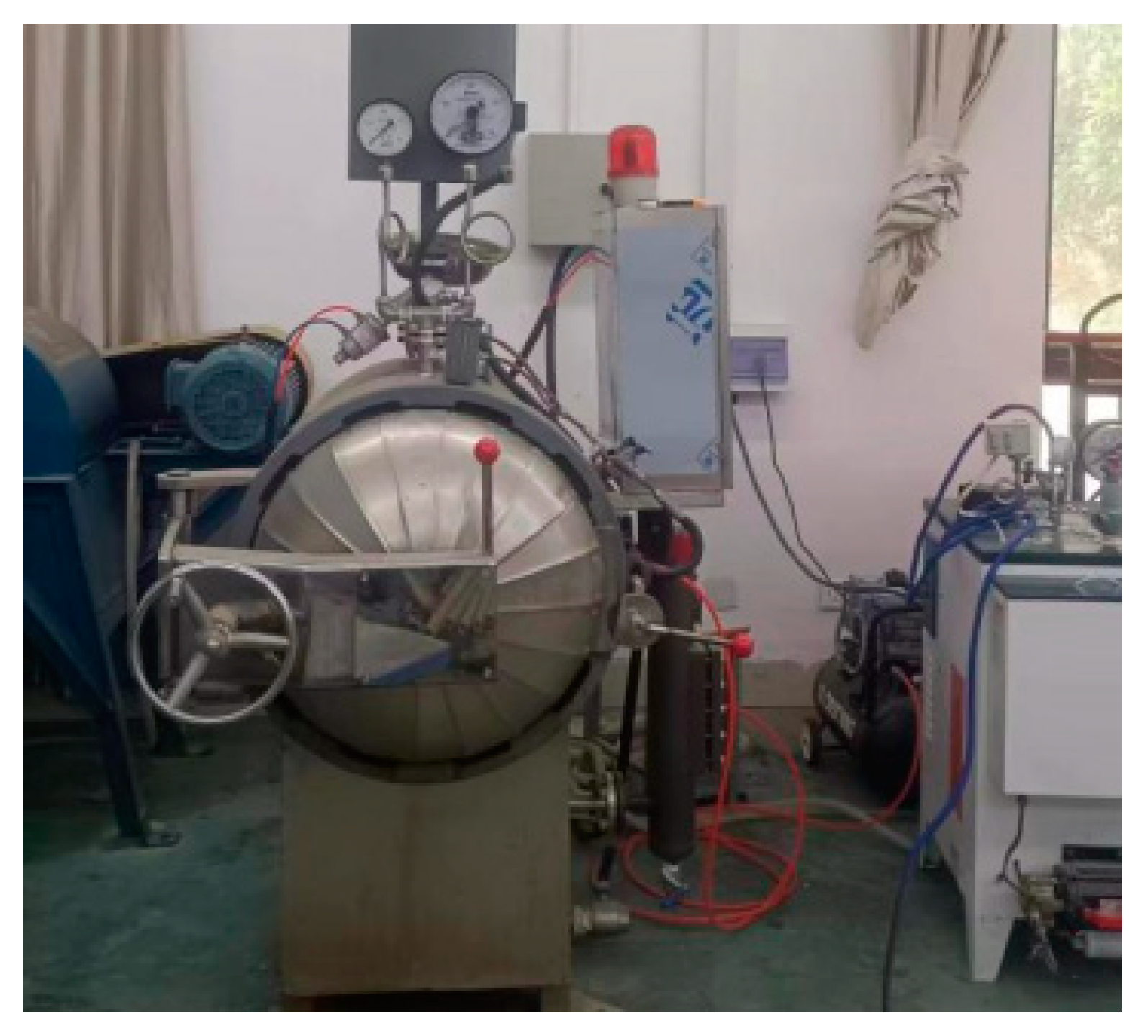
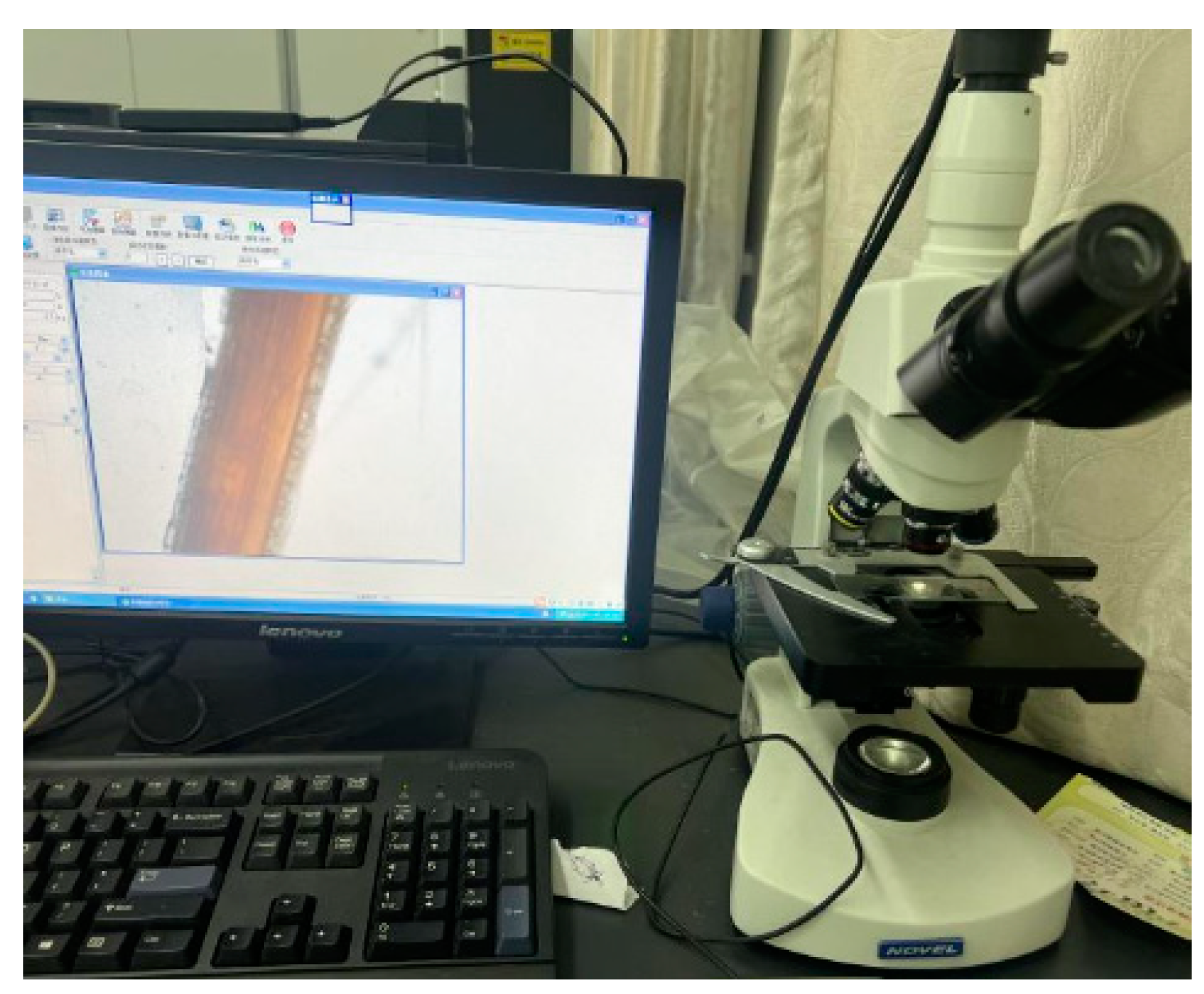
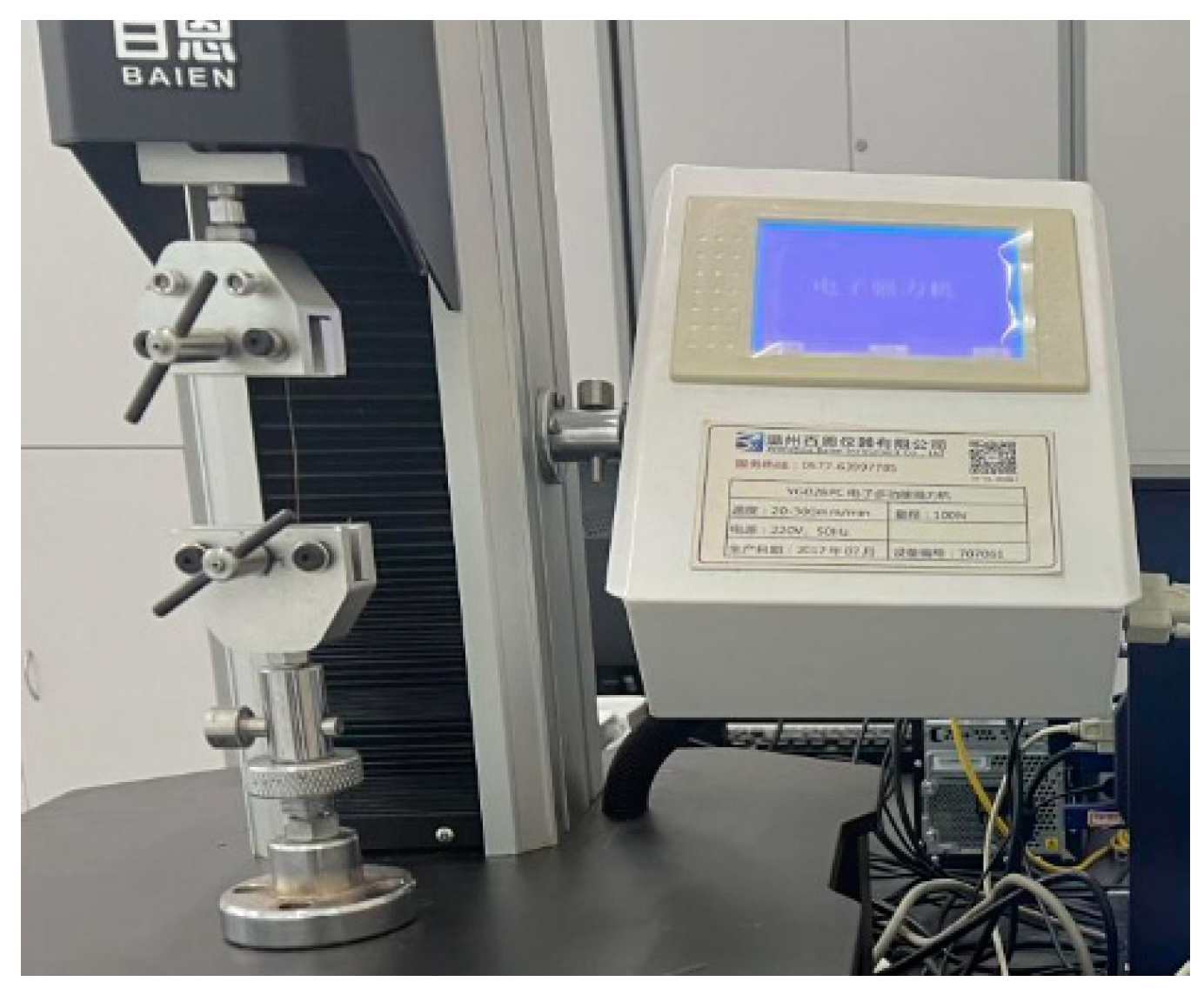


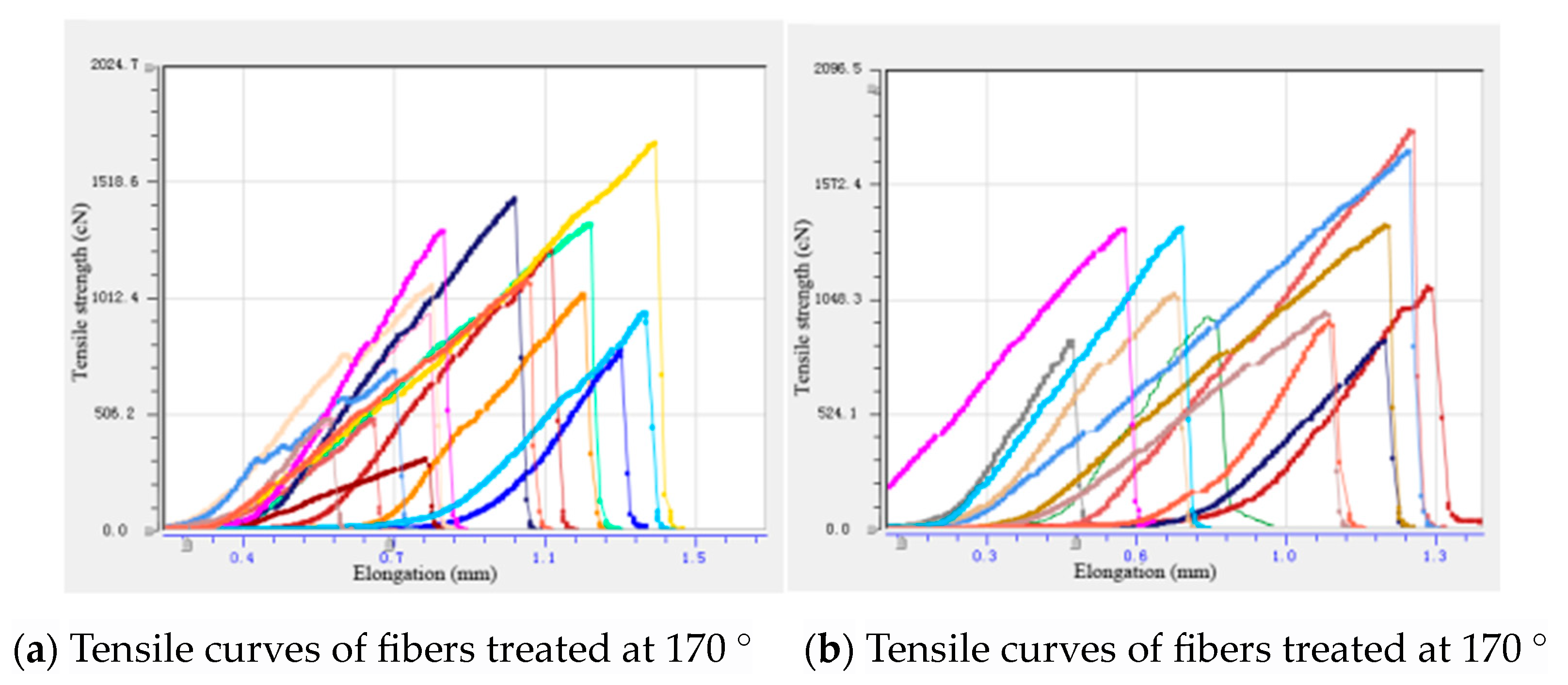
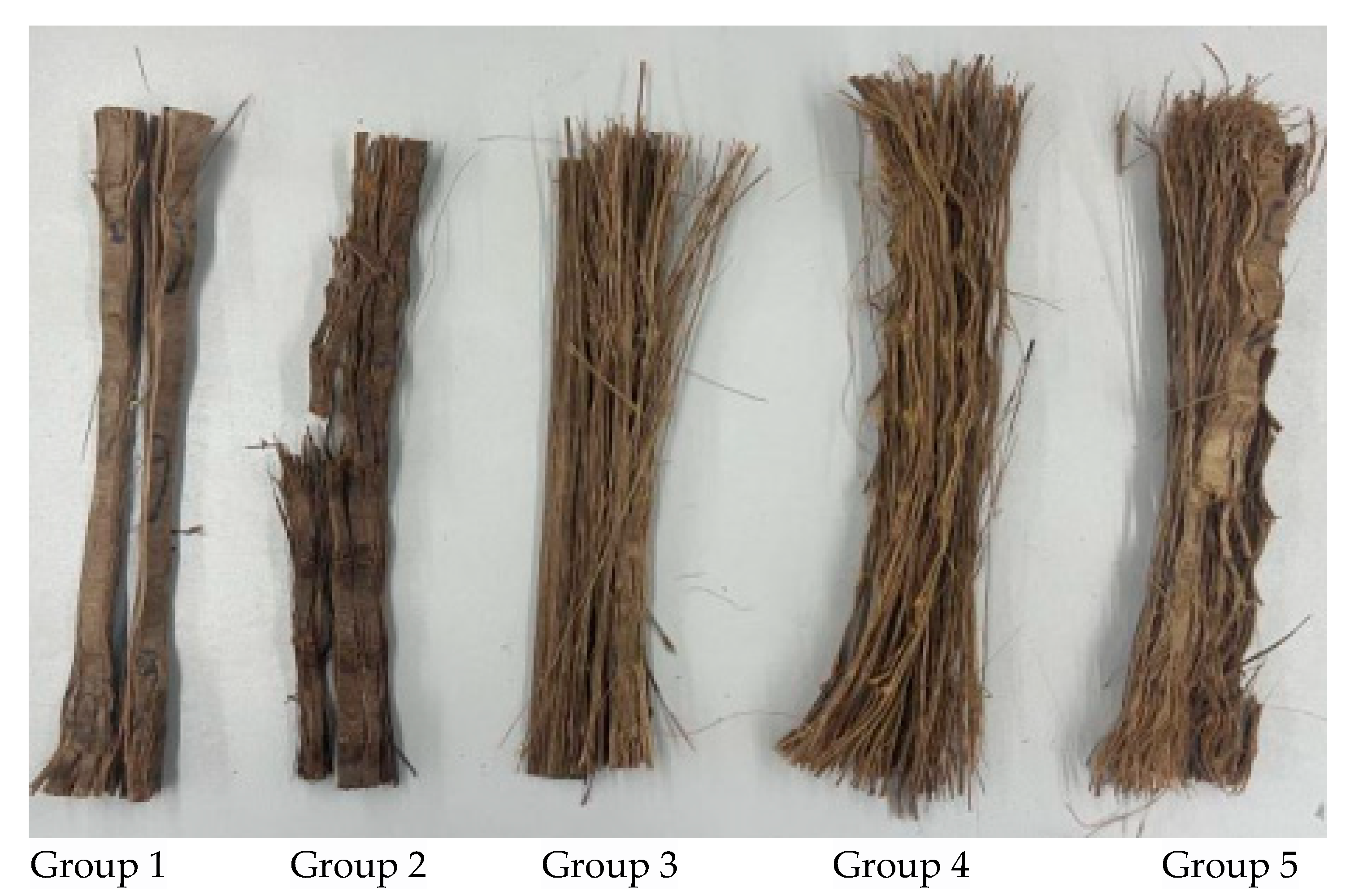
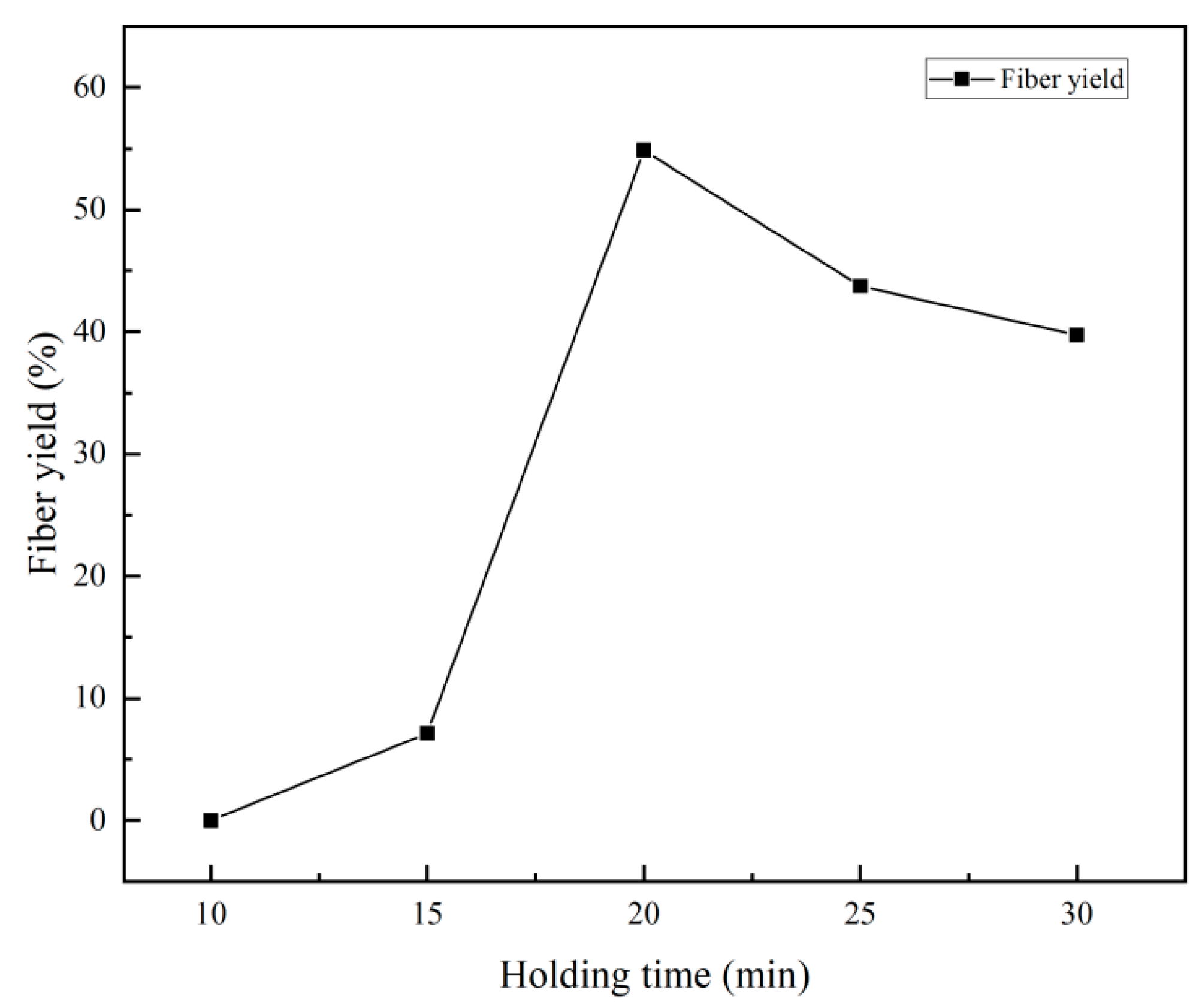
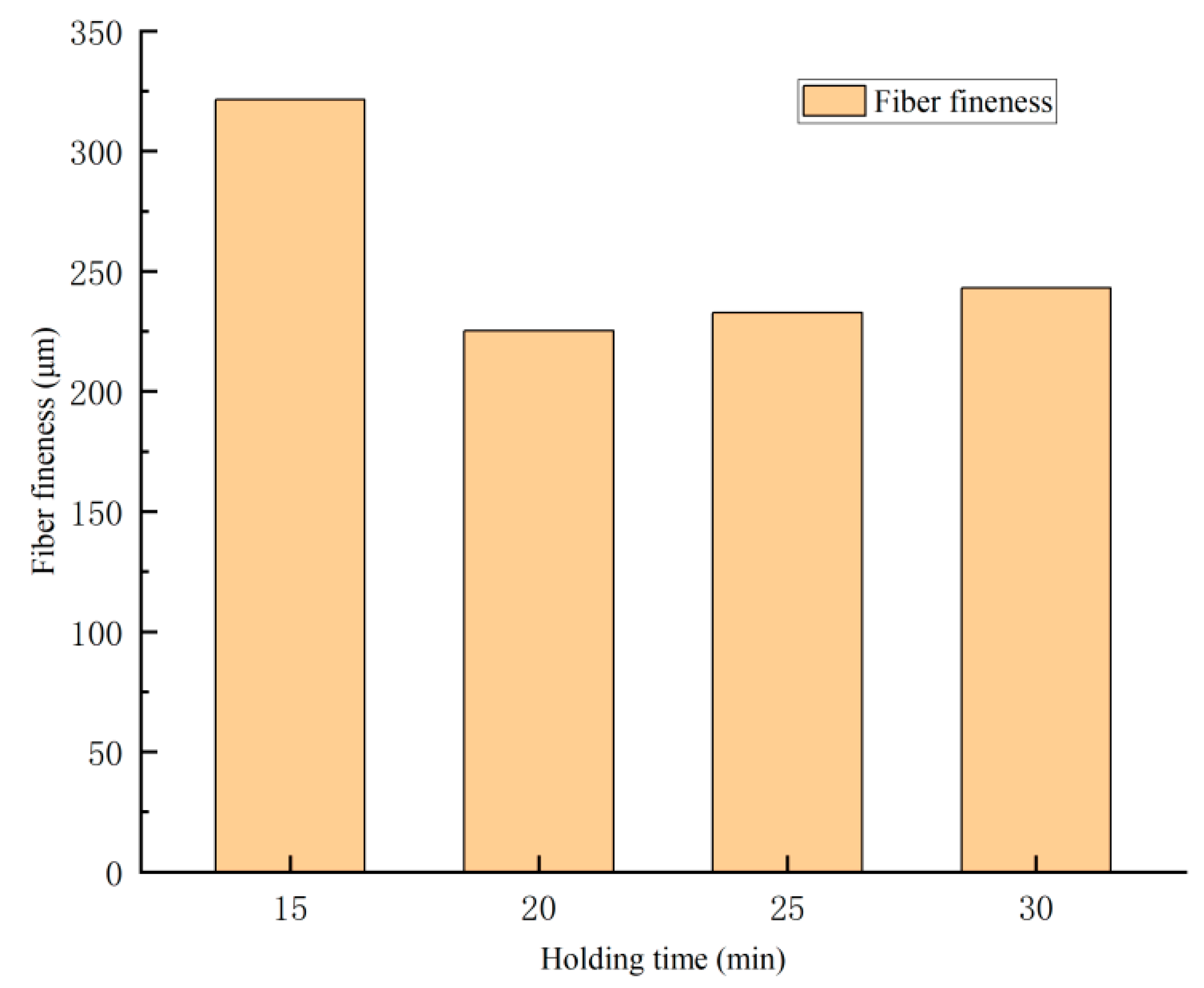
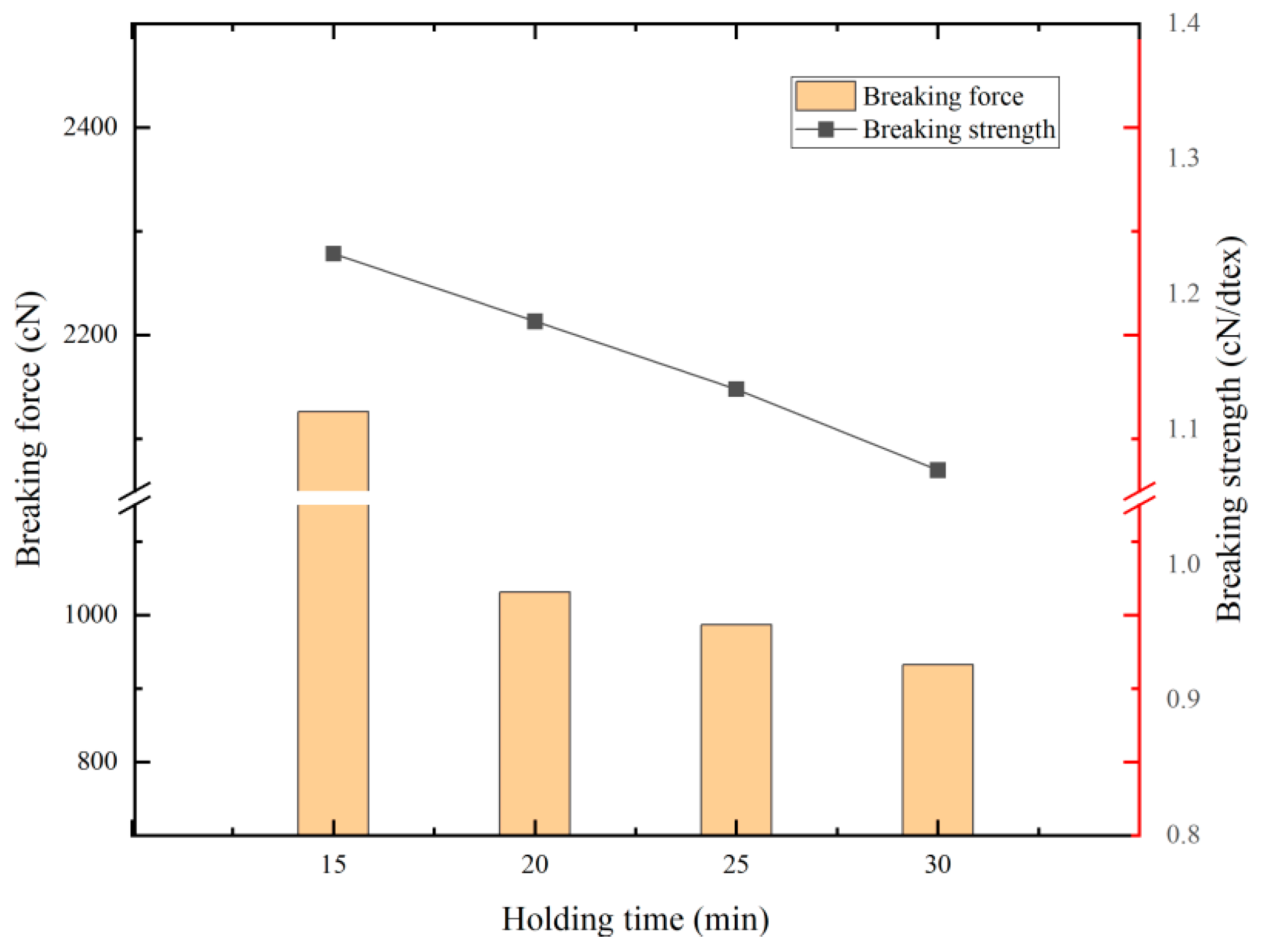

| Group | Group 1 | Group 2 | Group 3 | Group 4 | Group 5 |
|---|---|---|---|---|---|
| Moisture content of Pleioblastus amarus specimens (%) | 22 | ||||
| Heating and holding time (min) | 20 | ||||
| Saturated steam temperature (°C) | 0 | 150 | 160 | 170 | 180 |
| Group | Group 1 | Group 2 | Group 3 | Group 4 | Group 5 |
|---|---|---|---|---|---|
| Moisture content of Pleioblastus amarus specimens (%) | 22 | ||||
| Saturation steam temperature (°C) | 170 | ||||
| Heating and holding time (min) | 10 | 15 | 20 | 25 | 30 |
| Temperature (°C) | Initial Bamboo Slice Mass (g) | Mass of Fibers after Oven-Drying (g) | Fiber Yield (%) |
|---|---|---|---|
| 0 | 63.5 | / | / |
| 150 | 69.83 | / | / |
| 160 | 63.3 | / | / |
| 170 | 67.6 | 34.72 | 54.85 |
| 180 | 62.98 | 22.96 | 36.45 |
| Steam Temperature (°C) | Maximum Value (μm) | Minimum Value (μm) | Average Value (μm) | CV Value (%) |
|---|---|---|---|---|
| 170 | 300 | 79.2 | 225.18 | 26.01 |
| 180 | 308.04 | 94.8 | 222.12 | 35.23 |
| Steam Temperature (°C) | Breaking Force (cN) | Breaking Strength (cN/dtex) | Elongation at Break (mm) | Breaking Elongation Ratio (%) | Elastic Modulus (cN/dtex) |
|---|---|---|---|---|---|
| 170 | 1031.48 | 1.18 | 0.93 | 1.85 | 132.03 |
| 180 | 1188.68 | 1.36 | 1.25 | 1.24 | 164.38 |
| Drying Time (min) | Moisture Content (%) | Fiber Yield (%) |
|---|---|---|
| 0 | 22 | 54.85 |
| 5 | 18.4 | 56.66 |
| 10 | 12.11 | 58.52 |
| 15 | 11.25 | 62.47 |
| 20 | 10.6 | 53.16 |
| 25 | 9.4 | 48.59 |
| 30 | 8.7 | 25.56 |
| Level | Steam Temperature (°C) | Holding Time (min) | Moisture Content (%) |
|---|---|---|---|
| 1 | 160 | 10 | 22 |
| 2 | 170 | 20 | 17 |
| 3 | 180 | 30 | 12 |
| No. | A Temperature (°C) | B Time (min) | C Moisture Content (%) | Blank Column | Fiber Yield (%) | Tensile Strength (cN) | Fiber Fineness (μm) |
|---|---|---|---|---|---|---|---|
| 1 | 160 | 10 | 22 | 1 | 0 | 0 | 0 |
| 2 | 160 | 20 | 12 | 2 | 0 | 0 | 0 |
| 3 | 160 | 30 | 17 | 3 | 9.32 | 1003.46 | 222.63 |
| 4 | 170 | 10 | 17 | 3 | 0 | 0 | 0 |
| 5 | 170 | 20 | 12 | 1 | 60.47 | 1204.66 | 192.27 |
| 6 | 170 | 30 | 22 | 2 | 39.74 | 932.86 | 243.10 |
| 7 | 180 | 10 | 17 | 2 | 7.45 | 1062.23 | 215.13 |
| 8 | 180 | 20 | 22 | 3 | 36.45 | 1188.68 | 222.12 |
| 9 | 180 | 30 | 12 | 1 | 44.77 | 1196.78 | 245.67 |
| K1 | 3.11 | 2.48 | 25.40 | Fiber yield: A > B > C | |||
| K2 | 33.40 | 32.31 | 5.59 | ||||
| K3 | 29.56 | 31.28 | 35.08 | ||||
| R | 30.30 | 29.82 | 29.49 | ||||
| Best choice | A2 | B2 | C3 | ||||
| K1 | 334.49 | 354.08 | 707.18 | Tensile strength: A > B > C | |||
| K2 | 712.51 | 797.78 | 688.56 | ||||
| K3 | 1149.23 | 1044.37 | 800.48 | ||||
| R | 814.74 | 690.29 | 93.30 | ||||
| Best choice | A3 | B3 | C3 | ||||
| K1 | 74.21 | 71.71 | 155.07 | Fiber fineness: C < A < B | |||
| K2 | 145.12 | 138.13 | 145.92 | ||||
| K3 | 227.64 | 237.13 | 145.98 | ||||
| R | 153.43 | 165.42 | 9.15 | ||||
| Best choice | A1 | B1 | C2 | ||||
| Indicator | Factor | Sum of Squares | Dof | Mean Square | F | Significance |
|---|---|---|---|---|---|---|
| Fiber yield (%) | A (°C) | 1,632.29 | 2 | 816.14 | 2.35 | 0.30 |
| B (min) | 664.29 | 2 | 332.15 | 0.96 | 0.51 | |
| C (%) | 300.48 | 2 | 150.24 | 0.43 | 0.70 | |
| Error | 694.09 | 2 | 347.05 | |||
| Tensile strength (cN) | A (°C) | 997,433.09 | 2 | 498,716.55 | 1.53 | 0.40 |
| B (min) | 806,687.43 | 2 | 403,343.72 | 1.24 | 0.45 | |
| C (%) | 94,086.32 | 2 | 47,043.16 | 0.14 | 0.87 | |
| Error | 652,846.29 | 2 | 326,423.15 | |||
| Fiber fineness (μm) | A (°C) | 35,378.47 | 2 | 17,689.23 | 1.82 | 0.35 |
| B (min) | 46,857.75 | 2 | 23,428.88 | 2.41 | 0.29 | |
| C (%) | 5,446.07 | 2 | 2,723.04 | 0.28 | 0.78 | |
| Error | 19,413.59 | 2 | 9,706.79 |
| Treatment Method | Yield (%) | Fitness (μm) | Tensile Strength (MPa) | Tensile Modulus (MPa) | Elongation at Break (%) |
|---|---|---|---|---|---|
| Saturated steam treatment | 60.47 | 192.27 | 125.58 | 11.49 | 2.14 |
| Alkali boiling treatment | 37.2 | 234.06 | 98.23 | 11.67 | 4.54 |
Disclaimer/Publisher’s Note: The statements, opinions and data contained in all publications are solely those of the individual author(s) and contributor(s) and not of MDPI and/or the editor(s). MDPI and/or the editor(s) disclaim responsibility for any injury to people or property resulting from any ideas, methods, instructions or products referred to in the content. |
© 2024 by the authors. Licensee MDPI, Basel, Switzerland. This article is an open access article distributed under the terms and conditions of the Creative Commons Attribution (CC BY) license (https://creativecommons.org/licenses/by/4.0/).
Share and Cite
Xu, X.; Fan, X.; Gong, Z.; Zhang, W. Experimental Study on Fiber Extraction after Saturated Steam Softening of Pleioblastus amarus. Forests 2024, 15, 1754. https://doi.org/10.3390/f15101754
Xu X, Fan X, Gong Z, Zhang W. Experimental Study on Fiber Extraction after Saturated Steam Softening of Pleioblastus amarus. Forests. 2024; 15(10):1754. https://doi.org/10.3390/f15101754
Chicago/Turabian StyleXu, Xiaofeng, Xingduo Fan, Zhenhong Gong, and Wei Zhang. 2024. "Experimental Study on Fiber Extraction after Saturated Steam Softening of Pleioblastus amarus" Forests 15, no. 10: 1754. https://doi.org/10.3390/f15101754
APA StyleXu, X., Fan, X., Gong, Z., & Zhang, W. (2024). Experimental Study on Fiber Extraction after Saturated Steam Softening of Pleioblastus amarus. Forests, 15(10), 1754. https://doi.org/10.3390/f15101754






